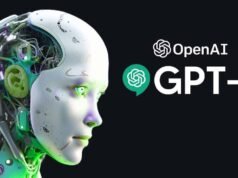Artificial intelligence is transforming numerous aspects of our lives. And one of the most visible manifestations of this transformation is the rapid evolution of AI chatbots. GPT-5 And 5G/6G Technology, the highly anticipated successor to GPT-4. Represents a significant leap forward in natural language processing and understanding.
This article delves into the potential capabilities of GPT-5. Explores its symbiotic relationship with 5G and 6G networks, and examines its diverse applications within the context of smart cities. We will also address the challenges and opportunities that lie ahead as we integrate these technologies into our urban environments.

Understanding GPT-5 And 5G/6G Technology: A New Era of AI Chatbots
While official details about GPT-5 are still scarce, we can infer its potential capabilities based on the advancements made in previous iterations and the ongoing research in the field of AI. GPT-5 is expected to surpass its predecessors in several key areas:
- Enhanced Natural Language Understanding. GPT-5 will likely exhibit a deeper understanding of the nuances of human language, including context, intent, sentiment, and even subtle cues like sarcasm or humor. This enhanced NLU will enable it to engage in more meaningful and context-aware conversations (Xu et al., 2023).
- Improved Reasoning and Problem-Solving. Beyond simply understanding language, GPT-5 is expected to demonstrate more advanced reasoning capabilities. It may be able to analyze complex problems, identify patterns, draw inferences, and provide more insightful and relevant solutions.
- Greater Creativity and Originality. GPT-5 could be capable of generating more creative and original content, making it a valuable tool for tasks such as content creation, storytelling, artistic expression, and even scientific discovery.
- Personalization and Adaptability. Future iterations of GPT models may be able to learn from user interactions and personalize their responses accordingly. This could lead to more engaging and effective chatbot experiences.
- Multimodal Capabilities. Integrating capabilities beyond text, such as image, audio, and video understanding, could allow GPT-5 to process and respond to a wider range of inputs, creating more immersive and interactive experiences.
- Increased Efficiency and Speed. Optimization improvements could lead to faster response times and more efficient resource utilization.
The Synergistic Relationship Between GPT-5 and 5G/6G Networks
The effectiveness and limitations of AI chatbots like GPT-5 depend heavily on the capabilities and constraints of the underlying network infrastructure. 5G and 6G technologies play a critical role in unlocking the full potential of advanced AI applications, particularly in smart cities:
5G: The Foundation for Smart City Connectivity
- High Speed and Low Latency: 5G offers significantly higher data speeds and lower latency compared to previous generations of mobile networks (Mahomed & Saha, 2025). This enables real-time communication and data processing, which is essential for many smart city applications.
- Massive Device Connectivity. 5G is designed to support a massive number of connected devices per square kilometer (Mahomed & Saha, 2025). This is crucial for smart cities, which rely on a dense network of sensors, cameras, and other IoT devices.
- Real-Time Digital Twin Integration. 5G facilitates the integration of real-time data from various sources into digital twins, allowing city planners and managers to monitor and optimize urban systems in real-time (Mahomed & Saha, 2025).
- AI technology has applications in healthcare, education, transportation, and urban ecology, with the potential to influence living conditions and environmental management (Xiong et al., 2022).
6G: Towards Hyper-Connectivity and Intelligent Ecosystems
- Ultra-High Bandwidth and Low Latency. 6G is projected to offer increased bandwidth and reduced latency compared to 5G, which may support applications like holographic communication and virtual reality. Though their practical implementation remains uncertain (Mizmizi et al., 2021).
- Connected Intelligence. 6G is envisioned as a shift from “connected things” to “connected intelligence” (Alsaedi et al., 2023). This requires more advanced AI technologies and a greater emphasis on data processing and analysis at the edge of the network.
- Autonomous Networks. 6G networks are expected to be more autonomous, using AI to self-optimize and adapt to changing network conditions (Adem et al., 2021).
- Multi-Dimensional Networks. 6G will encompass satellite, aerial, terrestrial, underwater, and underground communications (Rasti et al., 2021).

Applications of GPT-5 and Advanced Networks in Smart Cities
AI chatbots like GPT-5, powered by 5G and 6G networks, have the potential to revolutionize various aspects of smart city living:
Enhanced Public Services:
- AI-Powered Information Kiosks. Chatbots are sometimes integrated into public information kiosks to deliver information about city services, events, and landmarks. Though their usefulness can be limited by technical issues and user engagement challenges.
- Virtual Assistants for City Hall. Chatbots can handle routine inquiries and requests, freeing up city employees to focus on more complex tasks.
- Improved Emergency Response:
- AI-Driven Emergency Hotlines: Chatbots can triage emergency calls, gather critical information, and dispatch appropriate resources more efficiently.
- Real-Time Information Dissemination: During emergencies, chatbots can provide citizens with real-time updates, evacuation routes, and safety instructions.
- Smart Infrastructure Management:
- AI-Powered Energy Optimization: Chatbots can analyze energy consumption patterns and provide recommendations for optimizing energy usage in buildings and infrastructure.
- Predictive Maintenance. AI can be used to predict equipment failures and schedule maintenance proactively, reducing downtime and costs.
- Intelligent Transportation Systems:
- Generative AI-enabled vehicle-to-vehicle (V2V) networks. Leveraging multi-modal and semantic communication technologies to enhance the service quality of generative AI (Zhang et al., 2023).
- Real-Time Traffic Management: Chatbots can provide drivers with real-time traffic updates, suggest alternative routes, and help optimize traffic flow.
- Autonomous Vehicle Integration. 5G and 6G networks are essential for enabling autonomous vehicles, providing them with the low-latency connectivity they need to navigate safely and efficiently.
- Smart Homes and Buildings:
- AI-Powered Home Automation. Chatbots can control lighting, temperature, security systems, and other home devices, creating a more comfortable and energy-efficient living environment.
- Older people Care and Assistance. Chatbots can provide companionship, medication reminders, and emergency assistance to older residents, helping them to live independently for longer.
- AI and IoT for Smart Homes. AI is also being explored in securing IoT applications (Karmous et al., 2024).
Challenges and Considerations
Despite growing interest in GPT-5 and its integration with 5G/6G, the associated technical, social, and regulatory challenges remain substantial and unresolved.
- Data Security and Privacy: As AI chatbots handle increasingly sensitive data, ensuring data security and user privacy is paramount. Robust security measures and privacy-preserving technologies are essential.
- Ethical Considerations. AI algorithms often reflect existing biases, and their misuse or displacement of jobs raises unresolved ethical concerns. Current guidelines and regulations remain limited in scope and enforcement.
- Infrastructure Costs: Deploying 5G and 6G networks requires significant investments in infrastructure. Collaboration between governments and private companies is often necessary for network deployment, but ensuring equitable and affordable access remains a persistent challenge.
- Interdisciplinary Collaboration: Lack of shared vocabularies between urban planners and electronics researchers requires fostering interdisciplinary research frameworks.
- Digital Divide. Bridging the digital divide remains a significant obstacle, and access to smart city technologies is still uneven across different populations.
Future Research Directions
- Development of unified simulation platforms
- More city-scale antenna placement experiments
- AI-driven adaptive antenna networks responding to urban change
- Impact studies for GPT-5 And 5G/6G Technology in developing world cities with informal morphologies
- Exploring the potential ethical issues of new technologies in tourism marketing (Geng et al., 2024).
Conclusion
GPT-5 And 5G/6G Technology, in conjunction with the capabilities of 5G and 6G networks. Holds the transformative potential to revolutionize AI chatbots and their applications in smart cities. By proactively addressing the challenges, fostering collaboration, and prioritizing ethical considerations. We can harness the full power of these technologies to create urban environments that are more intelligent, efficient, sustainable, and equitable for all. The convergence of AI and advanced network technologies promises a future where cities are more responsive to the needs of their citizens, creating a higher quality of life for all.









